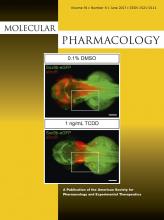Abstract
Phosphorylation of G protein-coupled receptors (GPCRs) is a key event for cell signaling and regulation of receptor function. Previously, using tandem mass spectrometry, we identified two phosphorylation sites at the distal C-terminal tail of the chemokine receptor CXCR4, but were unable to determine which specific residues were phosphorylated. Here, we demonstrate that serines (Ser) 346 and/or 347 (Ser-346/7) of CXCR4 are phosphorylated upon stimulation with the agonist CXCL12 as well as a CXCR4 pepducin, ATI-2341. ATI-2341, a Gαiβγ heterotrimer–biased CXCR4 agonist, induced more robust phosphorylation of Ser-346/7 compared with CXCL12. Knockdown of G protein-coupled receptor kinase (GRK) 2, GRK3, or GRK6 reduced CXCL12-induced phosphorylation of Ser-346/7 with GRK3 knockdown having the strongest effect, while inhibition of the conventional protein kinase C (PKC) isoforms, particularly PKCα, reduced phosphorylation of Ser-346/7 induced by either CXCL12 or ATI-2341. The loss of GRK3- or PKC-mediated phosphorylation of Ser-346/7 impaired the recruitment of β-arrestin to CXCR4. We also found that a pseudo-substrate peptide inhibitor for PKCζ effectively inhibited CXCR4 phosphorylation and signaling, most likely by functioning as a nonspecific CXCR4 antagonist. Together, these studies demonstrate the role Ser-346/7 plays in arrestin recruitment and initiation of receptor desensitization and provide insight into the dysregulation of CXCR4 observed in patients with various forms of WHIM syndrome.
Footnotes
- Received August 10, 2016.
- Accepted March 17, 2017.
↵1 Current affiliation: Merck & Co., Inc., Upper Gwynedd, Pennsylvania.
Research reported in this publication was supported in part by the National Institutes of Health [Grants R01GM044944, R01CA129626, and P30CA056036], by a grant from the Pennsylvania Department of Health, and by Deutsche Forschungsgemein-Schaft [Grant STU295/7-1 to R.S.].
- Copyright © 2017 by The American Society for Pharmacology and Experimental Therapeutics
MolPharm articles become freely available 12 months after publication, and remain freely available for 5 years.Non-open access articles that fall outside this five year window are available only to institutional subscribers and current ASPET members, or through the article purchase feature at the bottom of the page.
|






